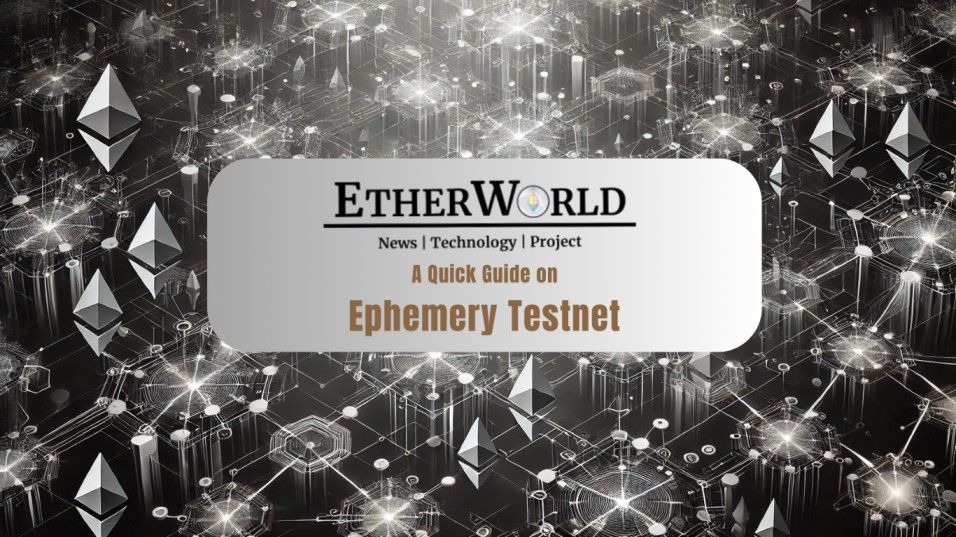Ethereum development requires rigorous testing environments before deploying upgrades, applications, or protocol changes to the mainnet. Traditional testnets such as Goerli, Sepolia, and Holesky provide this functionality, but they come with long-term state retention issues, congestion, and availability problems.
The Ephemery Testnet is designed as a temporary, resettable Ethereum test environment that provides developers with a clean slate every month. Unlike traditional testnets, it does not accumulate historical state, ensuring a fresh and interference-free testing environment.
This feature makes Ephemery particularly useful for rapid prototyping, debugging, and iterative development. One of the biggest milestones for Ephemery is the support for the Pectra hardfork, which brings new EIPs and network optimizations. Ephemery is now the first testnet to support the Pectra hardfork. Pectra was activated at Epoch 10 on February 13, 7 PM UTC.
- The Objective of an Ephemeral Ethereum Testnet
- What is Ephemery Testnet?
- How Ephemery Differs from Traditional Ethereum Testnets?
- Why Ephemery Matters for Ethereum Development?
- How Ephemery Works?
- Ephemery Testnet Infrastructure
- How Ephemery Helps Stakers & Validators?
- Challenges & Limitations of Ephemery
The Objective of an Ephemeral Ethereum Testnet
The core objective behind Ephemery is to address key limitations of long-running testnets, which include:
- State Bloat & Congestion: Over time, Ethereum testnets accumulate historical state, leading to increased storage requirements and performance bottlenecks.
- Lack of Available Testnet ETH: Developers often face difficulties acquiring test ETH on Goerli and Sepolia due to limited faucet distributions.
- Inactive Validators & Network Finality Issues: Long-lived testnets frequently suffer from abandoned validators, making it difficult to maintain network security and performance.
- Limited Opportunities for Short-Term Testing: Current testnets do not efficiently support short-term, disposable experiments, which are crucial for high-velocity development cycles.
Ephemery solves these issues by resetting itself at regular intervals (monthly), ensuring that each cycle begins with a clean blockchain state.
What is Ephemery Testnet?
The Ephemery Testnet is a specialized Ethereum test network that automatically resets to its genesis state every month. It operates as an ephemeral environment, meaning that all deployed contracts, validator setups, transactions, and network history are wiped clean periodically.
Key differences between Ephemery and traditional Ethereum testnets:
| Feature | Ephemery | Goerli/Sepolia/Holesky |
|---|---|---|
| State Persistence | Resets Monthly | Persistent |
| Validator Participation | Fully Open | Goerli/Sepolia: Restricted |
| ETH Supply | Reset Every Cycle | Limited Availability |
| Testing Scope | Short-Term Experiments | Long-Term Testing |
| Use Cases | Agile Development, Rapid Testing | dApp Deployment, Protocol Testing |
This ephemeral nature makes Ephemery ideal for early-stage testing of Ethereum protocol changes, EIPs, smart contracts, staking mechanics, and client releases.
How Ephemery Differs from Traditional Ethereum Testnets?
- Short-Lived, Cyclical Network: Unlike Goerli or Sepolia, which retain transaction history indefinitely, Ephemery resets every month to clear outdated contracts, state data, and network bloat. This ensures that each testing cycle begins fresh, free from past congestion and unwanted artifacts.
- Open Validator Participation: Any developer or staker can run a validator without prior approval, making it more accessible for staking-related testing. Validators are encouraged to join and leave freely, mirroring the dynamics of a real Ethereum staking environment.
- No Permanent State Accumulation: No need to worry about testnet funds exhaustion, as each reset replenishes the ETH supply. Developers can repeatedly test smart contracts, EIPs, and staking mechanisms without long-term consequences.
- Designed for Ethereum Core Development: Ephemery acts as a sandbox environment where Ethereum developers can experiment with protocol upgrades, fork testing, and new consensus mechanisms before pushing changes to larger testnets.
Why Ephemery Matters for Ethereum Development?
Ethereum’s continuous evolution relies on iterative testing before introducing major upgrades. Ephemery plays a crucial role by:
- Providing an Ideal Testing Ground for EIPs: Before EIPs reach Goerli or Sepolia, they can be validated in Ephemery. This reduces risks of major bugs affecting larger networks.
- Ensuring Developers Can Quickly Iterate on Smart Contracts: dApp developers can repeatedly test and optimize smart contract deployments without being affected by previous transactions. No need to manually clear outdated deployments since Ephemery resets automatically.
- Reducing Congestion on Persistent Testnets Goerli and Sepolia often become overloaded with old contracts and spam transactions. By shifting early-stage testing to Ephemery, developers can free up resources on longer-lived networks.
How Ephemery Works?
Ephemery operates using a static genesis model, meaning that every month, the network resets to its original state with a new genesis block. This prevents long-term state accumulation, which helps avoid storage bloat and ensures that developers always work in a clean, interference-free environment.
With each reset, validators and participants start fresh, allowing for better-controlled testing cycles without the burden of past transactions or outdated contracts. The network follows a predefined reset schedule that completely wipes out all smart contracts, account balances, transaction history, and validator states. This ensures that no residual data from previous cycles remains.
Test ETH is replenished automatically after each reset, allowing developers and validators to continue testing without resource limitations. Although the reset clears all transactional data, the network parameters remain unchanged, maintaining consistency across different testing phases.
One of Ephemery’s unique features is its fully open validator participation model, which makes it an essential tool for staking-related testing. Unlike Sepolia, which has a permissioned validator set, Ephemery allows anyone to deposit test ETH and run a validator without requiring prior approval. While there is a predefined genesis validator set at the start of each cycle, additional validators can freely join and exit the network, creating a more inclusive and dynamic testing environment.
Ephemery Testnet Infrastructure
Ephemery provides an official landing page where developers & validators can easily access:
- Network details (e.g., reset schedule, upgrade roadmap)
- RPC endpoints for connecting wallets & nodes
- Block explorers to track transactions & smart contract deployments
- Faucets to obtain test ETH for experimentation
Since test ETH is required for transactions & staking, Ephemery provides multiple faucet sources to replenish balances after each network reset.
| Faucet | URL |
|---|---|
| Bordel Faucet | https://faucet.bordel.wtf/ |
| PK910 Faucet | https://ephemery-faucet.pk910.de/ |
| API Faucet | https://api-faucet.bordel.wtf/ |
Since Ephemery resets every month, all balances reset as well, meaning users need a new batch of test ETH to continue experimenting.
Block explorers allow developers to track transactions, smart contracts, and validator operations. Ephemery supports multiple explorers:
| Explorer | Type | URL |
|---|---|---|
| Otter Explorer | Block Explorer | https://otter.bordel.wtf/ |
| Ephemery Explorer | Block Explorer | https://explorer.ephemery.dev/ |
| Ephemery Beacon | Beacon Explorer | https://beaconchain.ephemery.dev/ |
| Ephemery Info | Beacon Explorer | https://ephemery.info/ |
| Beacon Light | Beacon Explorer | https://beaconlight.ephemery.dev/ |
Block explorers show transaction history, smart contract data, & wallet activity. Beacon explorers track staking validators, epoch progress, & network consensus.
For faster node synchronization, Ephemery offers checkpoint sync endpoints, allowing nodes to bootstrap quickly instead of syncing from genesis.
| Checkpoint Sync | URL |
|---|---|
| Bordel Checkpoint | https://checkpointz.bordel.wtf/ |
| Beaconstate | https://ephemery.beaconstate.ethstaker.cc/ |
| EthPanda Sync | https://checkpoint-sync.ephemery.ethpandaops.io/ |
| ChainSafe Sync | https://beaconstate-ephemery.chainsafe.dev/ |
These endpoints significantly reduce the time required to sync a node, ensuring that developers & validators can start testing immediately.
How Ephemery Helps Stakers & Validators?
Ephemery provides a unique staking-focused testnet, making it the ideal choice for validator testing. It allows stakers to deploy validators without risk, experiment with Pectra’s MaxEB mechanism, and monitor validator performance under different conditions. Additionally, participants can freely exit the network without long-term commitments.
Since Ethereum staking demands precise configuration and reliability, Ephemery offers a short-term environment where stakers can fine-tune their setups before transitioning to the mainnet. It also serves as a low-risk sandbox to identify potential slashing risks and experiment with new Ethereum upgrades, such as Pectra’s validator aggregation, ensuring a smoother and more secure staking experience.
Challenges & Limitations of Ephemery
While Ephemery provides a highly efficient testing ground for Ethereum developers, it comes with inherent limitations due to its ephemeral nature.
- Lack of Long-Term State Retention: Since Ephemery resets every month, developers working on long-term projects must redeploy smart contracts & migrate balances frequently. This makes tracking ongoing dApp development more difficult compared to Goerli or Sepolia, which retain historical state.
- No Persistent Account Balances: Test ETH distributed within Ephemery does not persist beyond a single reset cycle. Developers & stakers must request new ETH from faucets every month.
- Not Suitable for Production-Ready dApps: Ephemery is meant for experimental testing, not production-ready applications. Unlike Goerli or Sepolia, which support persistent smart contracts & state, Ephemery does not retain deployed contracts after a reset.
- Validator Lifecycle & Network Finality: Since validators join and exit freely, maintaining network finality during short-lived test cycles can be challenging. Ephemery validators may not have enough time to test long-term staking performance.
Ephemery redefines Ethereum testing by providing a short-term, agile development cycle that eliminates traditional ethereum testnet issues. With a fresh Ethereum testnet every month, developers no longer have to deal with legacy issues, making it an ideal environment for testing new Ethereum upgrades like Pectra. It also serves as the best platform for staking research and validator testing, offering a unique resettable testnet specifically optimized for developers.
References
- Ephemery.dev – Official landing page.
- GitHub Repository – Source code & documentation.
Related Articles
_____________________________________________________________________Disclaimer: The information contained in this website is for general informational purposes only. The content provided on this website, including articles, blog posts, opinions, and analysis related to blockchain technology and cryptocurrencies, is not intended as financial or investment advice. The website and its content should not be relied upon for making financial decisions. Read full disclaimer and privacy Policy.
For Press Releases, project updates and guest posts publishing with us, email to contact@etherworld.co.
Subscribe to EtherWorld YouTube channel for ELI5 content.
Share if you like the content. Donate at avarch.eth or Gitcoin
You've something to share with the blockchain community, join us on Discord!








